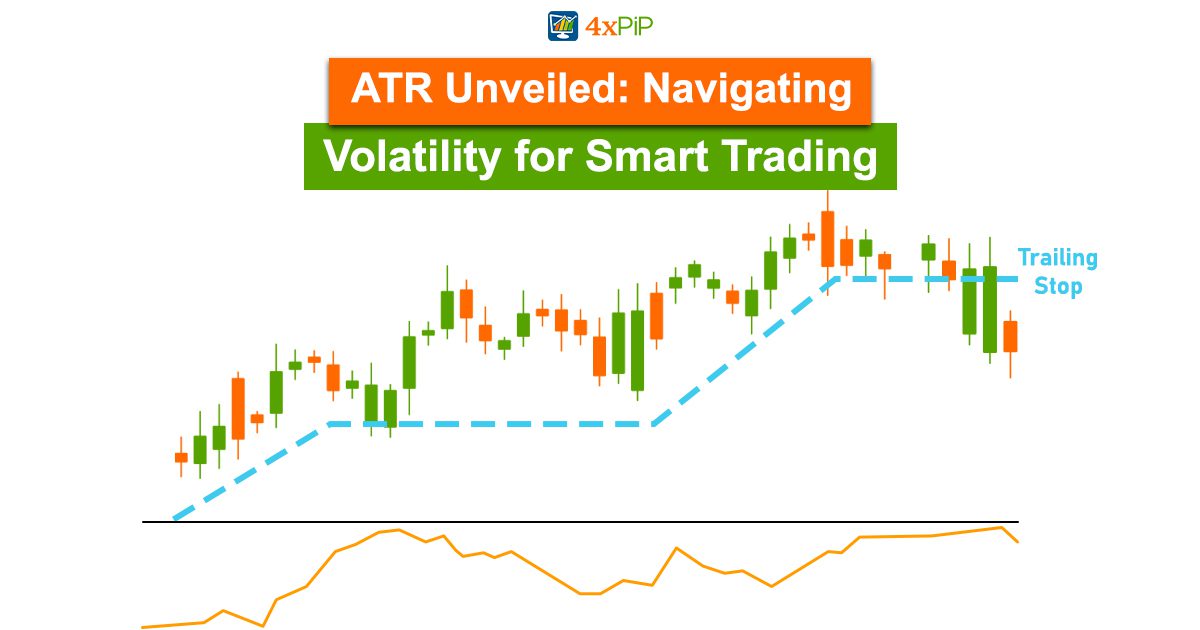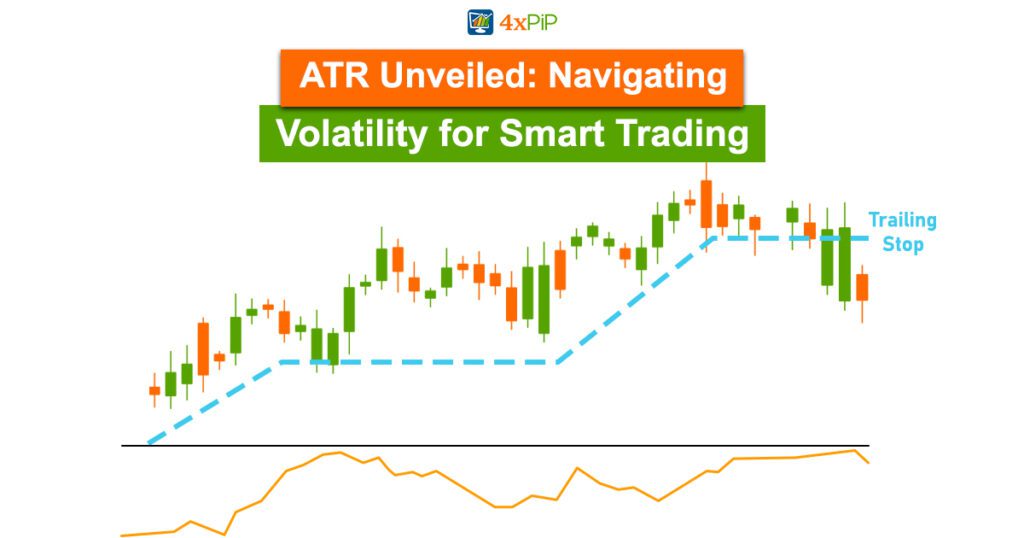Average True Range (ATR) is a crucial tool for traders and investors, providing insights into market volatility. Developed by J. Welles Wilder Jr., ATR measures the average range between high and low prices over a specific period, typically 14 days. In this blog, we’ll explore the practical applications of ATR, understand its calculation, interpret its values, and use it to optimize trading decisions.
4xpip Contact: For further inquiries and assistance, feel free to reach out to 4xpip at [email protected].
Understanding ATR: A Volatility Indicator:
What is ATR?

ATR is a volatility indicator that gauges potential price movements in the market. Its calculation involves the average range between high and low prices over a specified period, commonly 14 days. A higher ATR value indicates increased volatility, while a lower value suggests stability.
Pros, cons, and uses of ATR:
Pros of Using ATR:
Volatility Insight: ATR provides a clear understanding of market volatility, aiding traders in adapting their strategies.
Dynamic Stop-Loss: ATR assists in setting dynamic stop-loss levels, accounting for market fluctuations.
Cons of Using ATR:
Not Directional: ATR doesn’t indicate market direction, requiring additional analysis for comprehensive decision-making.
Practical Uses of ATR:
Setting Stop Loss and Take Profit: ATR helps determine optimal levels for setting stop-loss and take-profit orders.
Trailing Stops: ATR effectively implements trailing stops, allowing for potential profit expansion while safeguarding against reversals.
Calculating ATR: Method and Formula:
The True Range Calculation:
To compute ATR, we start by determining the true range (TR) for each period. TR considers the greatest of three values: the current high minus the current low, the absolute value of the current high minus the previous close, and the absolute value of the current low minus the previous close.
ATR Calculation Formula:
ATR is an exponential moving average (EMA) of the true range values over a specified period (commonly 14 days). The formula is ATR = EMA(TR, n), where TR is the true range, and n is the number of periods.
Example Calculation:
Consider a scenario with true range values of 1.2, 0.9, 1.5, 1.8, and 1.3 for the past five periods. Using a 14-period EMA, the ATR is calculated based on these values.
Importance of ATR for Determining Optimal Close Positions:
Assessing Volatility with ATR:
ATR’s primary role is assessing market volatility. Traders can utilize ATR values to determine close positions by setting appropriate stop-loss and take-profit levels.
Case Study: Swing Trading with ATR:
In swing trading, ATR aids in identifying reversals or trend continuations. Higher ATR values suggest increased volatility, prompting wider stop-loss levels to accommodate market fluctuations.
Case Study: Position Sizing with ATR:
ATR assists in determining optimal position sizes based on risk tolerance. By dividing the desired risk per trade by the ATR value, traders can calculate the number of shares or contracts to trade.
Tips for Utilizing ATR Effectively:
Multiple Timeframes: Analyze ATR on different timeframes for a comprehensive view of market volatility.
Combine with Other Indicators: Enhance ATR’s effectiveness by combining it with indicators like moving averages or trend lines for confirmation.
Identifying Overbought and Oversold Conditions with ATR:
Using ATR to Identify Overbought Conditions:
Significant increases in ATR can indicate overbought conditions. A sharp rise in ATR suggests heightened volatility, often preceding a market reversal.
Using ATR to Identify Oversold Conditions
Conversely, significant decreases in ATR may signal oversold conditions. ATR dropping sharply indicates decreased volatility, potentially preceding a market bounce-back.
Tips for Identifying Overbought and Oversold Conditions:
Confirmation with Other Indicators: Use other technical indicators to confirm overbought or oversold conditions.
Consider Multiple Timeframes: Assess ATR values on various timeframes for a more accurate assessment.
Case Study: Identifying Overbought and Oversold Conditions:
Observe a hypothetical stock where increasing ATR values suggest overbought conditions, prompting traders to assess potential reversals.
Utilizing ATR to Set Stop Loss and Take Profit Levels:
Setting Stop Loss Levels with ATR:
ATR helps set dynamic stop-loss levels, considering the inherent volatility of an asset. Wider stop-loss levels during high ATR periods accommodate fluctuations.
Determining to Take Profit Levels with ATR:
Similar to stop-loss, ATR aids in setting realistic take-profit levels. Traders adjust profit targets with market volatility based on ATR values.
Tips for Utilizing ATR in Stop Loss and Take Profit Placement:
Adapt Levels Based on ATR: Adjust stop-loss and take-profit levels according to the prevailing ATR, ensuring they align with market conditions.
Combine with Trailing Stops: Utilize trailing stop strategies based on ATR, allowing for potential profit expansion while protecting against reversals.
Incorporating ATR in Position Sizing and Risk Management:
Determining Position Size Based on ATR:
ATR plays a crucial role in position sizing and risk management. By factoring ATR into stop-loss calculations, traders adapt their position sizes to market volatility.
Case Study: Incorporating ATR in Position Sizing:
In a hypothetical case, a trader calculates position size based on a $50,000 trading account, a 2% risk per trade, and a current ATR value.
Tips for Incorporating ATR in Position Sizing:
Regularly Update ATR Values: Market conditions change, so routinely update ATR values to align with current volatility.
Trailing Stop Strategies: Implement trailing stops adjusted based on ATR for effective risk management.
Examples of Using ATR to Determine Optimal Close Positions:
Case Study 1: Swing Trading with ATR:
Explore a swing trading scenario where ATR assists in identifying optimal close positions based on volatility trends.
Case Study 2: Position Sizing with ATR:
Understand how ATR is applied in position sizing, ensuring that position sizes align with risk tolerance and market conditions.
Case Study 3: Trend Following with ATR:
Discover how ATR aids in trend-following strategies, enabling traders to stay in positions until ATR indicates potential trend reversals.
Case Study 4: Volatility Breakout Trading:
Learn how ATR assists in volatility breakout trading, allowing traders to set profit targets based on multiples of ATR.
Tips for Utilizing ATR Effectively:
Combine with Other Indicators: Enhance ATR’s effectiveness by combining it with other technical indicators for more accurate signals.
Regularly Review and Adjust: Market conditions evolve, so regularly review and adjust ATR settings to align with the dynamic market environment.
Conclusion:
In conclusion, Average True Range (ATR) stands as a powerful ally for traders and investors navigating the dynamic landscape of financial markets. By providing insights into volatility, ATR empowers individuals to make informed decisions regarding stop-loss, take-profit, and position sizing. Its versatility is evident in applications such as swing trading, trend following, and volatility breakout strategies. When used judiciously and in conjunction with other indicators, ATR becomes a valuable tool for optimizing trading strategies and managing risk effectively.
For further guidance or inquiries, don’t hesitate to contact 4xpip at [email protected].





